The tree wasn’t a towering oak on the rolling landscape of a New York City park, a magnificent elm with big-shouldered limbs, or a bright, showy dogwood welcoming the spring on a village street. It was, in fact, the most unlikely of survivors, sort of scrawny, alone, between city buildings and flanking some very inhospitable pavement and metal. But survive and hang in there? Yes, it did.
In fact, this highly unusual tree on the block of Greenwich Street between West 10th and Charles streets was like no other I’ve seen in New York. It adapted to survive while chain-link fence impinged on it, to the point of the trunk having the fence’s pattern carved into its surface, as documented in a Mindfulwalker.com photo essay in 2011. (See “A Tree Grows in Chain Link.”) If this tree ever heralded anything, it might have been the message that life can be tough but don’t let it defeat you.
It survived this way for quite a while. I made periodic walks to this block of Greenwich Street to check up on this tree and say hello, usually during early spring or fall. Even when not visiting, I thought of the special, feisty tree on Greenwich Street. As this winter was giving way to spring, I decided to pay a visit. However, as I was walking the blocks of the West Village, I had a sense that it was like a friend with whom I lost touch for too long. Something could be amiss, and it was – the tree was gone. The fence and driveway looked cleaner and tidier, yet emptier and sadder to this visitor who had felt a bond with the tree.
The tree on Greenwich Street in 2011, for a photo essay
The site in front of the building in 2016
What had become of it? A local merchant said the building owner had taken down the tree about a year ago. My friend, this tree, had become a nuisance apparently, with its tree roots pushing on the building foundation. That was just like it, I thought, not surprised. Did removing it make sense? Perhaps, but no doubt this side of the street appears emptier in its absence.
Living Spirits
Late last week, many marked Arbor Day, and the lone tree on this block of Greenwich Street came to mind as worth remembering, especially while seeing the posts and tweets honoring trees all over the world. The idea of a holiday to plant and honor trees came from a newspaper editor who became an official in the Nebraska Territory, J. Sterling Morton. He first proposed the idea in 1872.
Having moved from Michigan, Morton and his wife, Caroline, a pioneer couple on the Great Plains who loved nature, planted their land full of the trees they missed. The trees would bring shade, protect the soil from breaking up due to the swirling Plains winds, and provide building materials, as the Arbor Day Foundation recounts. In 1885, Arbor Day became a legal holiday in Nebraska, and the idea spread to other states and schools across the country.
In the original idea of Arbor Day lies the essence of how special, life-affirming, and precious a tree is. Trees are living spirits, each one individual. Certainly, lovelier, grander, and more productive trees have graced the earth. Yet this tree on the block of Greenwich Street between West 10th and Charles streets made a great impression the very first time I walked by it. How could it have survived this environment? Co-existing with the metal fence, it grew right alongside it, though it wasn’t leafy or looking entirely healthy. Like the New Yorker it was, the tree insisted on having its space.
The 2011 photo shows how the tree was linked to the metal fence.
A fence remains now, but the tree is gone.
We tend to imbue trees with human qualities, and certainly many come to mind for this tree: feisty, strong, stubborn, quirky, in-your-face, and persistent. In a city that counts 5.2 million trees with some 592,000 street trees, this was just one tree and not the most beautiful one at that. Yet, there’s no denying it was a unique character of a tree, one this New Yorker won’t forget.
The fence pattern in the tree trunk, in 2011
The foot of the trunk, in 2011
A close-up today of the base of the fence, without the tree.
The tree in front of the building, in 2011
Photo Essay, 2011: A Tree Grows in Chain Link
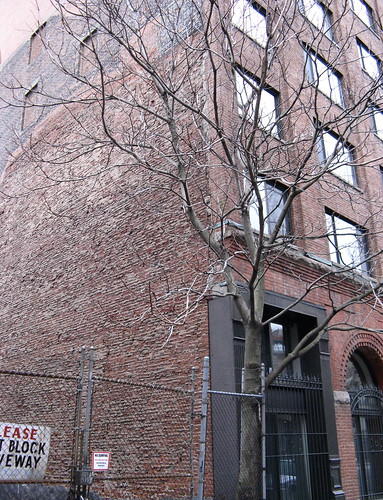

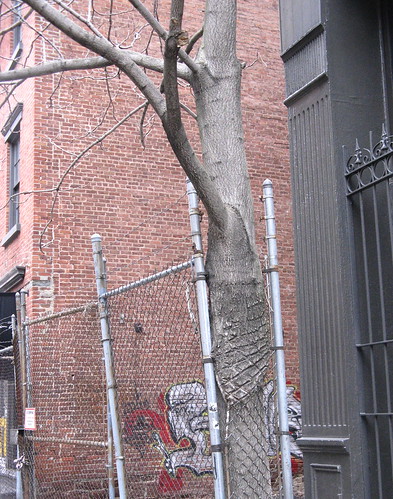
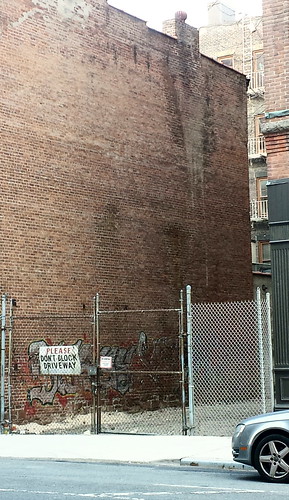
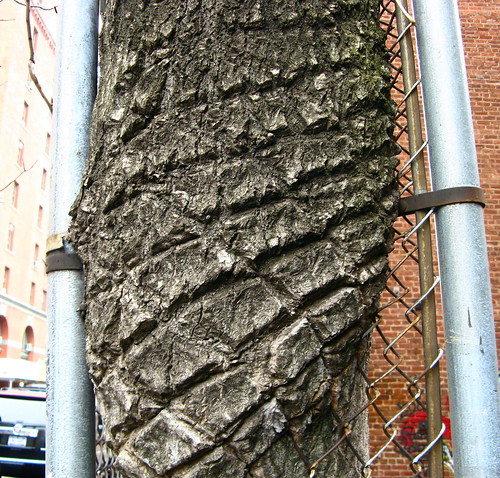
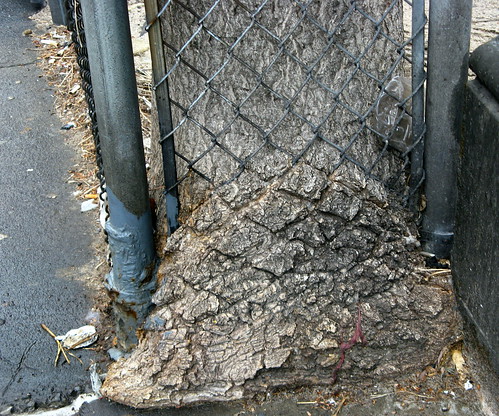
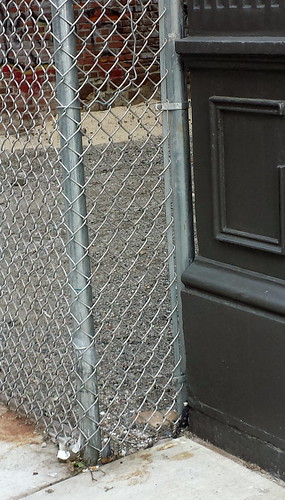
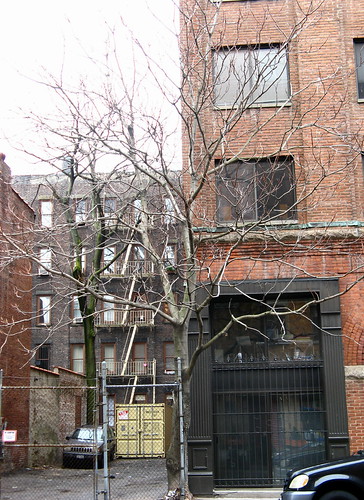



Great essay! I am happy I’m not alone in bonding with trees. I have a favorite on an otherwise ugly highway in front of a big office building. My favorite season to view it is winter because it has a perfect almond shape otherwise obscured by its leaves. I’m sorry for the loss of your tree. Like all of them, it was a true original.
Shannon,
Such wonderful observations! Thinking of your favorite tree on that highway and this special (now gone) one on Greenwich Street makes me think of singular trees that bring some respite of nature and beauty in the middle of places that aren’t so welcoming. (You said it better, I believe.) The almond shape of your tree sounds lovely!
Thank you!
Susan
As a fellow tree-hugger (literally), I could identify with your sense of loss, Susan! It would even have been sweet to have a section of the fence-imprinted bark as you show in your photo. That lot is the emptier for losing that tree. You know where my favorite big hemlocks are!
Gretchen,
The lot does look quite bare, doesn’t it? I know how you prize your trees, as you do all of nature. I find it interesting, as you allude to in citing your “favorite big hemlocks,” how lovers of trees find special ones, whether a group or a singular one, in each place we live. I do believe they are friends!
Yes, it would have been something else to have a piece of that amazing tree in my environs, with the spirit its wood possessed. I can only think of it now going into that stream of life resurrecting in other forms.
Thank you so much for your lovely observations, from your fellow tree-hugger,
Susan
Knew that tree as well. So sorry she is gone…
Exactly, Lynne…a sad turn of events that she is gone.